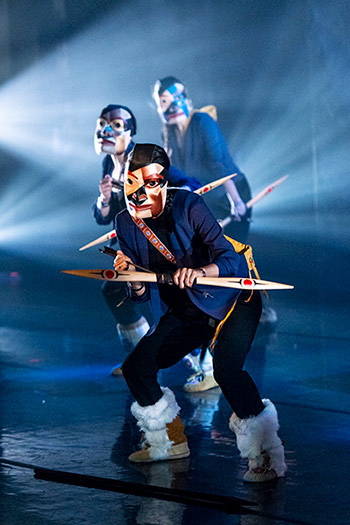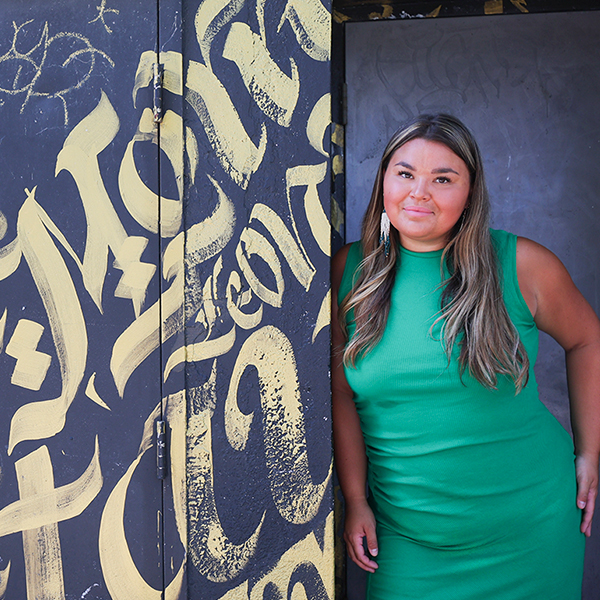A few years ago, Margaret Grenier, BSc’97, was performing at an elementary school in Vancouver with the Dancers of Damelahamid, the Indigenous dance company her parents founded in the 1960s (she is now the group’s artistic and executive director). They opened with a Cree dance by Grenier’s mother that tells a story called “The girl who wished on a star,” accompanied by a song called the “Love Song.”
“It’s a very gentle way to open a performance,” Grenier says. “Especially one that’s for children.”
As they performed, a kindergarten-aged child in the front row of the audience kept saying, “This is so beautiful. How is this so beautiful?” Grenier remembers.
It’s a memory Grenier says she holds with her. “It’s a reminder that there is something in everything that we do,” she says, “And the openheartedness with which you share it, and how, or when, or where that reaches someone – you just have to have faith in that, and not have a preconceived idea of what a possible successful connection could look like.”
Grenier’s father, Ken Harris, a hereditary Gitsxan chief, and her mother, Margaret Harris, who is Cree, founded the Dancers of Damelahamid as a form of cultural revitalization. The dance company is an intergenerational family storytelling practice that uses songs, masked dances, and multimedia presentations to convey Gitsxan teachings and understandings about land and political relationships, and how landscapes and communities have changed over time.

where the Dancers of Damelahamid are based, has a rich tradition of masked dance.
Prior to the potlatch ban, which made the practicing of Indigenous cultural ceremonies a criminal offense from 1880 to 1951 in Canada, the dances had only been shared within Gitsxan feast halls; previous generations’ decisions to perform these dances more publicly, Grenier says, meant that she was able to grow up learning them, and learning from them, herself.
Before COVID hit, the Dancers of Damelahamid performed about 50 school visits each year, in addition to the creation, development, and touring of larger productions. At the onset of the pandemic, the group had just wrapped up their work at their annual Coastal Dance Festival; they have completed one virtual performance during the pandemic, which took much more work and effort to do carefully and safely.
When she was young, Grenier lived with her family on Gitsxan land, in communities around Prince Rupert. She learned stories and dances as she went from place to place in the territory with her family. “Travelling along the Skeena River, my father would point out places, and tell me the story of that mountain, or tell me the story of whatever place we were driving by or where we had stopped,” she says. “And so those stories, which, like all of our stories, have a very specific location in which they take place, became very much a part of my access to understanding the knowledge, to connecting them to place, but also in dancing them, it became a tangible connection and experience that I was just immersed in.”
Those experiences help shape the way she approaches her work with the Dancers of Damelahamid. Her efforts recently earned her one of Canada’s top artistic prizes – the Walter Carsen Prize for Excellence in the Performing Arts.
Awarded by the Canada Council of the Arts, the prize recognizes the highest level of artistic excellence and distinguished career achievement by a Canadian professional artist in music, theatre or dance. Previous winners include some of the biggest names in the Canadian dance world, including Marie Chouinard, Veronica Tennant and Menaka Thakkar, as well as composer R. Murray Schafer and playwright Judith Thomson.
Reflecting on winning the Walter Carsen Prize, Grenier notes that she is its first Indigenous recipient; receiving the prize wasn’t just a recognition of her work as an individual, but of the work of her parents, and previous generations, to ensure that the practice was not lost.
Grenier also credits her deep roots in her culture, and the dances and stories passed down in her family, when she discusses the ways in which the Dancers of Damelahamid has changed under her tenure. The oral histories represented in the dances, Grenier says, are not static, but rather something that people contributed to.
“I know that my life is not intended to replicate what my parents did with cultural revitalization,” Grenier says, “but to offer contemporary stories that are rooted in this tradition but are also speaking to what Indigenous people are experiencing now, and what we have experienced in our recent history, with significant changes to our language, to our culture, to our communities.”
Grenier has been dancing with the company since 1991. The Dancers of Damelahamid has performed nationally and internationally, with a special focus on reaching out to young people.
She did her undergraduate degree at McGill in geography and environmental studies. “When I first started at McGill, there was a lot of encouragement, if you were an Indigenous student that did well in sciences, to go into sciences and pursue that,” she recalls.
“There just wasn’t enough representation of [Indigenous] students in sciences, in general. I think that I shifted towards environmental sciences, because I think that the values and the way that it was taught [at McGill] aligned very well with my ways of understanding, from the Indigenous teachings and knowledge that I grew up with.”
During her time at McGill, Grenier was part of a six-person Indigenous student committee that helped lead a successful protest against the logo that was used on the helmets of the McGill football team at the time – a stereotypical image of an Indigenous person wearing a headdress.
Grenier notes that McGill recently made the decision to finally retire the problematic Redmen name for sports teams altogether. She has university-aged children of her own now. She is struck by how Canadians are still having the same conversations around colonialism and our relationship with Indigenous Peoples that we were having in the 1960s, when her parents founded their dance company, and in the 1990s, when she was studying at McGill.
“In some senses, we feel like, why are we not there yet?” she says. “And then, on the other hand, I think we’re always reminded that we have so much work to do.”


